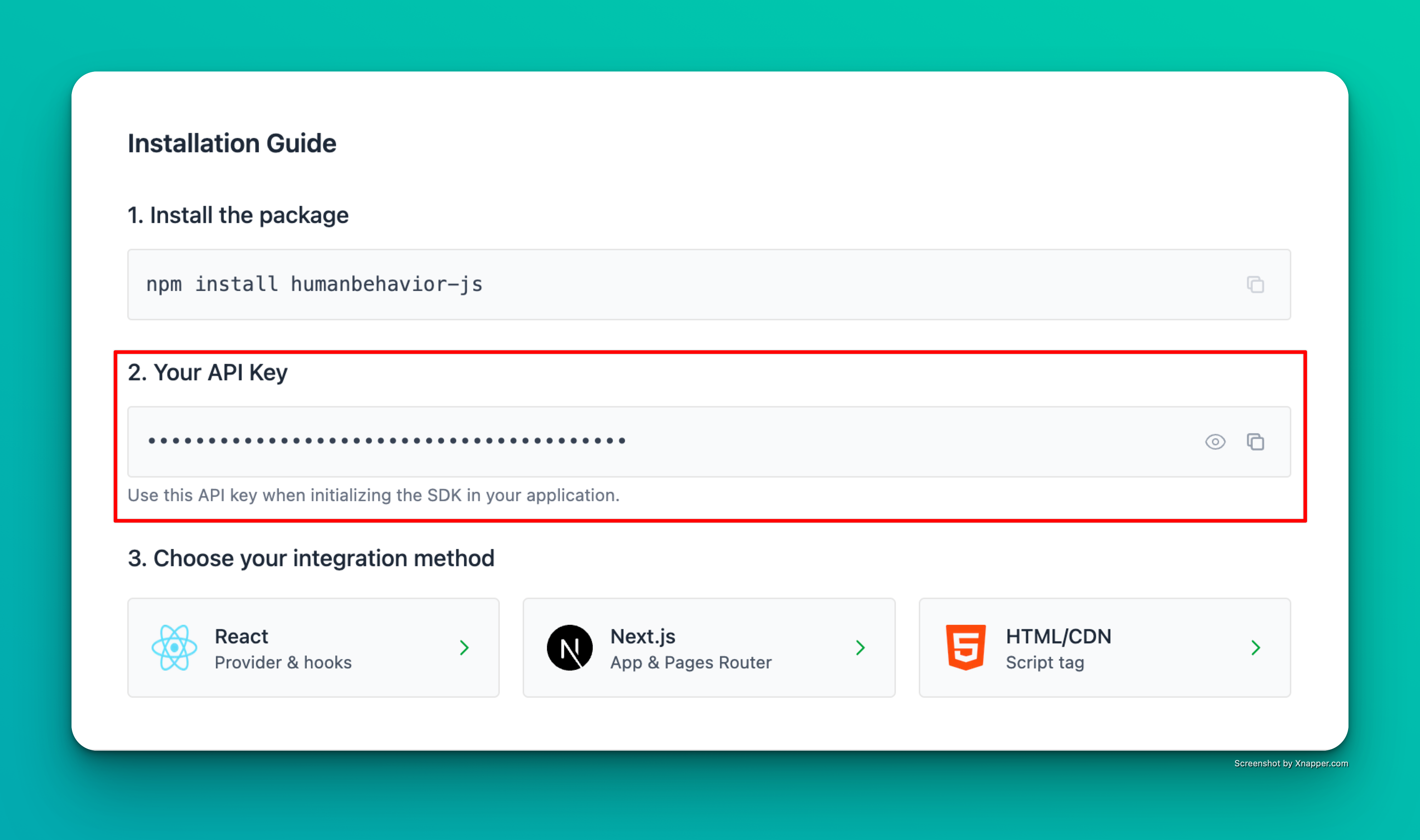Quickstart
Human Behavior works seamlessly to record sessions on your Vue.js app.
Show How to get your API Key
How to find your Public API Key:
Flow: Project Home → Integrations → Human Behavior SDK → Kebab Menu → Configuration → Public API Key

Example screenshot – your actual API key will be different.
Step 1: Installation
npm install humanbehavior-js
# or
yarn add humanbehavior-js
Step 2: Environment Variables
Create an environment file (.env) with your API key:
VITE_HUMANBEHAVIOR_API_KEY=your-api-key-here
Important: For Vite-based Vue projects, environment variables must start with VITE_ to be accessible in the browser.
Step 3: Create HumanBehavior Composable
Create src/composables/useHumanBehavior.ts:
import { HumanBehaviorTracker } from 'humanbehavior-js'
export function useHumanBehavior() {
const apiKey = import.meta.env.VITE_HUMANBEHAVIOR_API_KEY
if (apiKey) {
const tracker = HumanBehaviorTracker.init(apiKey, undefined, {
logLevel: 'debug'
})
return { tracker }
}
return { tracker: null }
}
Step 4: Initialize in Router
Update src/router/index.ts:
import { createRouter, createWebHistory } from 'vue-router'
import HomeView from '../views/HomeView.vue'
import { useHumanBehavior } from '@/composables/useHumanBehavior'
const router = createRouter({
history: createWebHistory(import.meta.env.BASE_URL),
routes: [
{
path: '/',
name: 'home',
component: HomeView,
},
{
path: '/about',
name: 'about',
component: () => import('../views/AboutView.vue'),
},
],
})
// Initialize HumanBehavior
const { tracker } = useHumanBehavior()
export default router
Step 5: Use in Components
Now you can use HumanBehavior in any Vue component:
<template>
<div class="about">
<h1>About Page</h1>
<button @click="handleClick">Test HumanBehavior</button>
<router-link to="/">Go to Home</router-link>
</div>
</template>
<script setup lang="ts">
import { useHumanBehavior } from '@/composables/useHumanBehavior'
const { tracker } = useHumanBehavior()
function handleClick() {
tracker?.customEvent('button_clicked', { button: 'test' })
}
function identifyUser() {
tracker?.identifyUser({
userProperties: { email: 'user@example.com' }
})
}
</script>
Alternative: Provide/Inject Pattern
If you prefer to use Vue’s provide/inject system instead of composables:
Initialize in main.ts
import { createApp } from 'vue'
import App from './App.vue'
import { HumanBehaviorTracker } from 'humanbehavior-js'
const app = createApp(App)
const apiKey = import.meta.env.VITE_HUMANBEHAVIOR_API_KEY
if (apiKey) {
const tracker = HumanBehaviorTracker.init(apiKey, undefined, {
logLevel: 'debug'
})
app.provide('humanBehavior', tracker)
}
app.mount('#app')
Inject in Components
<script setup lang="ts">
import { inject } from 'vue'
const tracker = inject('humanBehavior')
function handleClick() {
tracker?.customEvent('button_clicked')
}
</script>
That’s it! The SDK now automatically tracks user interactions, navigation, and console events. Everything past here is optional.
Features
- ✅ Vue 3 Composition API support
- ✅ Composable-based architecture
- ✅ Provide/inject pattern support
- ✅ Automatic session recording
- ✅ Custom event tracking
- ✅ User identification
- ✅ TypeScript support included
Troubleshooting
- Check browser console for any error messages
- Verify your API key is correct and starts with
VITE_
- Ensure the tracker is initialized before any user interaction
- Make sure
.env is in your project root directory
- For Vue CLI projects, use
VUE_APP_ prefix instead of VITE_


